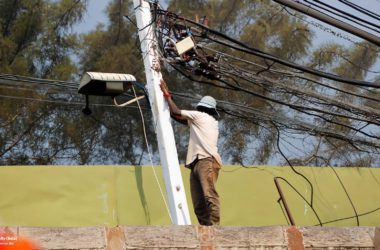Table of Contents Show
Mobile apps are a powerful tool for power distribution companies (DISCOMs) to connect with their consumers. Most DISCOM apps today offer features like bill payment, complaint registration, applying for new connections, and raising service queries. But let’s be honest—these apps often don’t get the traction they deserve.
Whether it’s bill payment, outage alerts, or complaint resolution, a well-designed DISCOM app can be a game-changer.
Yet, most DISCOM apps see low adoption. Why?
Because people use these apps once a month, at best. And with limited phone storage (especially 32 or 64 GB models), utility apps often lose out to social media, OTT platforms, or other “must-have” apps. Unless the DISCOM app adds real, frequent value, it’s unlikely to make it onto consumers’ home screens.
More factors can be classified as follows:
- Limited storage on mobile phones
- Infrequent use of utility services
- Lack of consumer awareness
- Uninspiring user experience
To increase user engagement and drive adoption, DISCOMs must think like modern app developers—offering value, simplicity, and personalisation.
Unless the DISCOM app adds real, frequent value, it’s unlikely to make it onto consumers’ home screens.
Here are 10 smart strategies to make your utility app a daily-use essential.
1. Keep It Simple, Swift, and Consumer-Centric
The best apps are intuitive. Your consumers shouldn’t have to dig through layers of menus to pay a bill or raise a complaint.
Your app’s user interface (UI) should follow the “three-tap rule”—any important action (like paying a bill or registering a complaint) should not take more than three taps.
Avoid clutter. Use visual icons and consistent layout patterns.
Consumers today are used to smooth digital experiences from apps like Google Pay and Amazon—yours should be no different. Design with simplicity: prioritize essential features on the home screen and use familiar gestures like “swipe to pay.” Clear, consistent Call to Action (CTA) buttons can greatly improve navigation and user satisfaction.
Quick Tips:
- Place “Bill Payment” and “Outage Info” front and centre.
- Use tooltips for guidance.
- Integrate biometric login (Face ID/Fingerprint) for faster access.
2. Educate with Walkthroughs, Tooltips & Videos
An app is only as good as its users’ understanding of it. First-time users often feel overwhelmed, especially when apps cater to technical services. Many users uninstall apps because they don’t know how to use them. A quick in-app walkthrough or a short explainer video can solve that.
Embed:
- Onboarding tours with highlighted features
- How-to videos on payment, complaint registration, and outage tracking
- FAQs or “Help” sections in both English and local languages
Tip: Add these videos to your app’s Play Store/App Store page too. It makes onboarding smoother and boosts consumer confidence.

3. Don’t Just Launch—Continuously Market the App
Unlike entertainment apps, DISCOM apps aren’t inherently “sticky.” A utility app won’t go viral like a game—but consistent and creative marketing can drive installs.
Keep reminding your consumers about the app through:
- Electricity bills, calendars, visiting cards
- Posters at service centers and public meetings
- Social media, FM radio, and even newspapers (QR codes work great here!)
Assign someone in your team the specific responsibility of driving app installs—especially during complaint resolutions or new connection setups.
Offline Ideas:
- QR codes on printed bills, cash counters, complaint books
- Posters at billing centres, transformers, and substations
- Stickers on service vans and linemen’s kits
Online Ideas:
- Monthly social media campaigns (e.g., “Download & Win”)
- WhatsApp broadcasts with download links
- In-app referral rewards
Designate a Mobile App Champion in each DISCOM subdivision to promote installs during routine site visits.
4. Build a Robust Support and Troubleshooting Ecosystem
Consumers abandon apps when they hit bugs, slow loading screens, or unclear error messages. Not every user will report an issue via official channels. Some may tweet, others may silently uninstall the app.
Ensure:
- A dedicated in-app support chat or call-back feature
- FAQ integration with ticket logging
- Support scripts and training for field engineers and call center reps
Your support team should know the app inside out so they can guide users during complaint calls or physical visits. To prevent silent drop-offs:
- Assign backend support staff to monitor issues and respond proactively.
- Ensure your call center and field staff are trained to guide consumers on app usage.
- Have an easy-to-access troubleshooting/help section in the app.

5. Trim the Fat: Small App Size, Minimal Permissions
Consumers hesitate to install bulky apps or those asking for too many permissions. A 100 MB app is an instant turn-off—especially in areas with low bandwidth or older phones.
Make your app lightweight and only request permissions that are absolutely necessary. This increases trust and encourages more installs.
Best Practices:
- Keep the APK size <20 MB
- Avoid unnecessary permissions like camera/microphone unless needed
- Use progressive loading for images and updates
Smaller, trustworthy apps are more likely to be installed and retained.
6. Segment Consumers for Hyper-Targeted Messaging
Leverage consumer indexing to offer hyperlocal updates. A farmer in rural Jharkhand doesn’t need the same notifications as a shopkeeper in Jaipur.
Segment users by:
- Geography
- Feeder or DT location
- Consumer category (domestic, commercial, industrial)
- Language preference
Send relevant alerts and notifications:
- Planned outages
- Maintenance downtime alerts
- Payment due reminders
- Load shedding plans
- Regulatory updates such as public hearing notices and tariff updates
Timely, accurate communication builds trust.
7. Let Users Personalise Their Experience
Allow users to personalise their experience. Apps that adapt to users win. Let consumers customise their interface and communication.
Offer features such as:
- Dark/light mode
- Choice of font size (for elderly users)
- Language preference
- Notification types and timings
- Default payment methods (UPI, net banking, wallet)
Also, allow consumers to select preferred billing dates where regulatory norms permit.
Consumers love flexibility—and they’ll reward it with continued app usage.

8. Use Analytics to Improve UX and Backend Services
Your app is a goldmine of consumer behaviour data.Connect your app with tools like Firebase or Google Analytics to track:
- Drop-off points in the app
- Most-used features
- Time spent on different screens
- Regions with poor adoption
- Highly complex processes which need simplification
Use this data to simplify features, address common pain points, and improve backend workflows.
Example: If many industrial users keep checking the “Power Factor” tab, consider a short educational video or webinar on power factor correction equipment.
Bonus: If users frequently check their bill history, offer visual graphs to track usage trends.
9. Be Thoughtful with Notifications
Avoid the cardinal sin of spamming your users. Avoid sending alerts late at night or during holidays. Schedule notifications during reasonable hours and let consumers opt-in to the type and timing of alerts. Publicize this respectful approach—it’ll increase goodwill.
Implement the following:
- Silent hours (e.g., no push notifications between 9 PM–7 AM)
- Bundled updates instead of multiple daily pings
- User-controlled frequency (daily, weekly, monthly)
A polite app builds trust and enhances brand image.
10. Turn Reviews into a Goldmine of Insights
Reviews in app stores offer free Voice of Customer (VoC). Analyze both negative and positive reviews.
Assign someone to track reviews weekly and categorise them:
- Login issues
- UI complaints
- Payment gateway problems
- Suggestions for new features
Publicly respond to reviews—especially negative ones. It shows you’re listening and improving. Address them through regular app updates.
Also, analyse reviews of competitor apps. What do users love? What do they hate? Learn from both.
Conclusion:
In a world dominated by mobile-first services, your DISCOM app can be more than a transactional platform—it can be a digital bridge between you and your consumers.
A well-designed DISCOM app can dramatically improve consumer engagement, reduce footfall at service centers, and boost overall satisfaction. But it takes more than just building a feature-rich app. You need to listen, learn, adapt, and evolve continuously.
Start small, measure progress, and evolve continuously. Your consumers—and your call centres—will thank you.
Start with these 10 ideas, and you’ll be well on your way to turning your app into a truly valuable consumer asset.






